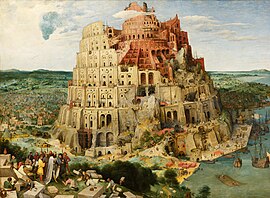The Tower of Babel (Bruegels)
It has been suggested that this article be merged into The Tower of Babel (Bruegel). (Discuss) Proposed since April 2016. |
| The Tower of Babel | |
|---|---|
 | |
| Artist | Pieter Bruegel the Elder |
| Year | 1563 |
| Type | oil on wood |
| Dimensions | 114 cm × 155 cm (45 in × 61 in) |
| Location | Kunsthistorisches Museum |
The Great Tower of Babel is a painting by Pieter Bruegel the Elder from 1563, at the Kunsthistorisches Museum Vienna. The thememe is described in the First Book of Moses, Tower of Babel. It is an oil painting on wood with the dimensions 114 cm x 155 cm. A second version dated 1563 , the Small Tower of Babel in the Museum Boijmans Van Beuningen in Rotterdam.
Das painting
Structure and Content
The viewer looks at medium height on a bean-like foreground, which falls in a polder landscape. The central focus is a gigantic tower construction site which serves on a single rock as a foundation. On the hill on the bottom left is a king arriving with his entourage, before some prostrate workers. The others continue their work. Behind the tower construction site with its own port a cityscape is spreading. The building rests on a safe retaining walls with powerful ring, that rises to the ramp and spiral higher. It has already grown so powerful that it shaded part of the city. Numerous tiny figure silhouettes on site provide an additional impression of size. The outer walls are made of limestone, and reddish bricks are used for the inner walls. Bruegel shows the construction techniques of his time: Treadwheel are in use, falsework used for the Barrel vault construction and masons carve sandstone blocks.[1]
Galerie
-
King with entourage
-
The peak above the clouds
-
Sillouette figure
-
A Tretkran
-
vault with falsework
Interpretation
The theme is described in the First Book of Moses Tower of Babel:

Bruegel sets biblical events in his time and home - so he lets the builder King Nimrod[2] occur in a Dutch polder landscape. The kowtow, performed by the stonemasons, has oriental origins of the story.
A model for the construction of the Roman Colosseum, however, in a reversal, since its rising outward passages converge inside. The story of the tower is an example of an overbearing, ultimately impossible undertaking. After Klaus Demus, this is reflected in Bruegel's combination of spiral and multi-storeyed. This is an impossible structure as the tower in the interior would have the structure of a snail. "The design is a deliberate impossibility, an ingenious absurdity abysmal irony with respect to all rationality. For screw and Storied, onion, subjects work and conical agitator with radial tubes: This is no architectural marvel, but a triumph of artistic idea that it could pronounce the tower itself that it could be not only not machined according, but not built "the inclination of the tower to the left comes from the fact that the builders had set the vertical at a right angle to the ramp, he was so" wrong thinking ".[1]
Exhibition, provenance
The Tower was painted in 1566 by Bruegel for Nicolaes Jonghelinck and went probably in the same year in the city of Antwerp. It then was owned by Rudolf II. And is later detected in the Leopold Wilhelm collection. Today it is the Bruegelsammlung the Kunsthistorisches Museum in Vienna (Hall 10, inventory number GG 1026). Signed at the bottom of the painting is on a square: "Brvegel. FE. M.CCCCC.LXIII ".[3]
References
- ^ a b Klaus Demus: Der Turmbau zu Babel in Pieter Bruegel d. Ä. im Kunsthistorischen Museum Wien (Hg. Wilfried Seipel) skira editore, Milano 2008 ISBN 978-3-85497-133-7 S. 56f
- ^ Christian Vöhringer: Pieter Bruegel. 1525/30–1569.
- ^ Template:Wayback




